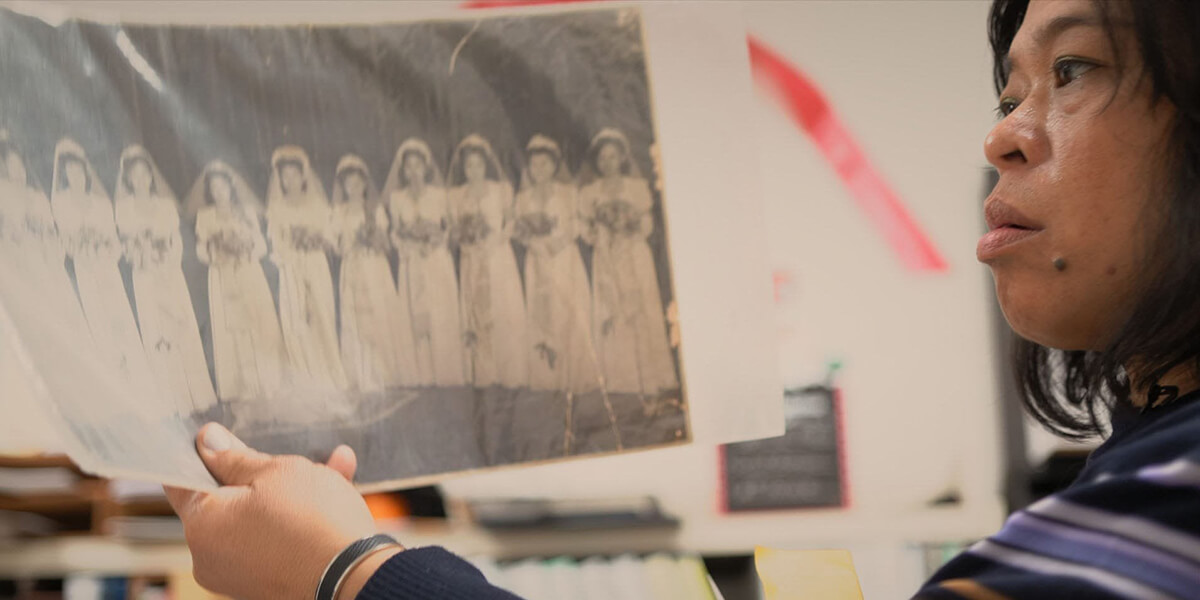
The so-called ghost story of a 28-year-old woman buried alive in the Sacramento Delta in 1932 is recast as the tragedy of a doomed feminist heroine in a new documentary set to screen at film festivals worldwide. “The Celine Archive,” from School of Cinema Director Celine Parreñas Shimizu, revisits the gruesome death of Celine Navarro against the backdrop of a Filipino migrant community under siege during the Great Depression.
“Along with the fascinating figure of Celine Navarro, this documentary paints a vivid portrait of the early Filipino migrant community struggling with widespread racism and their own poisonous misogyny,” critic Ryan Wu wrote for the Los Angeles Asian Pacific Film Festival, where the documentary premiered this month. “It’s a haunting and illuminating experience.”
An émigré from the Philippines, Navarro settled in Stockton in 1918 and got married in 1924. Known as a shy, caring mother of four and a beloved babysitter, she also refused to let her voice be stifled, once testifying in court against four men she witnessed beating a woman. All four were convicted and sentenced to prison. Navarro faced torturous retaliation for her testimony in the following months. Members of a local Filipino fraternal organization kidnapped Navarro twice, accusing her of adultery and stealing from her husband. The third time, she was taken to Jersey Island in Contra Costa County, where seven people dug a grave and buried her alive. In a high-profile trial sensationalized by the media as involving a “secret Filipino cult,” all were acquitted.
Shimizu said Navarro’s family still lives with the legacy and memory of the murder. “Celine was not only killed by her own community, but the community organized the defense of her indicted killers,” Shimizu said. “Think about what that did to her family. It tells a story of betrayal by that very community. It’s a story of an undoing of your community.”
Professor Shimizu’s film tells Navarro’s story through archival documents and news clippings, audio recordings and new interviews with surviving relatives and historians. Late Associate Professor of History Dawn Bohulano Mabalon and former Asian American Studies Adjunct Professor Alex Fabros also appear.
“Filipino kids used to have this ghost story of a woman who got buried alive,” Fabros Jr. says in the film. He says elders would tell the story to children at migrant labor camps at night, shining a flashlight through an old leather glove to startle them. Fabros assumed it was just a fictional tale until 1994, when one of his SF State students mentioned the case and showed him a historical document.
“My student said, ‘No no, it’s a real story.’ I’ve got it right here,’” Fabros said. Between 1994 and 1996, about 200 of Fabros’ SF State students would do further research into the Navarro case with him.
Making “The Celine Archive” has helped Shimizu cope with a loss in her own life: Her 8-year-old son Lakas died unexpectedly on Christmas Day in 2013.
“While Celine’s sisters were able to gather when grandson Henie Navarro replaced the gravestone marked ‘unknown’ with her name, Celine never got a funeral for her many descendants. By making this film, I realized that is something I can make happen,” Shimizu said. “Her story is a reckoning of the silences in our community, but also of making grief come to the surface so we can have a real connection across our families.”
Numerous SF State students helped make “The Celine Archive.” Dan Chein (B.A., Anthropology, ’11; MFA, Cinema, ’18) is director of photography. Jon Ayon Alonso (B.A., Cinema, ’17) edited the film, and alum David Sandwisch is sound designer. Ten undergraduates transcribed interviews, conducted archival research and participated in production and post-production.
“The Celine Archive” won a Gold Remi Award for Historical Biography at WorldFest Houston. It screened across California at the Bay Area’s CAAMFest and internationally through the LA Femme festival. The 69-minute film is also slated for festivals in San Diego, Hollywood, Montreal, Chicago, Seattle and Switzerland.
With the exposure Shimizu’s film provides, she hopes it contributes to creating more dialogue about misogyny, especially for women from marginalized communities.
“The #MeToo moment has allowed us to talk about this more openly,” she said, “so young girls and women do not have to feel silenced and unable to tell stories of racial uplift at the expense of sharing their experiences of gendered hierarchy within their communities.”
For more on “The Celine Archive,” read Professor Shimizu’s new essay for Frontiers, a women studies journal.
— Matt Itelson